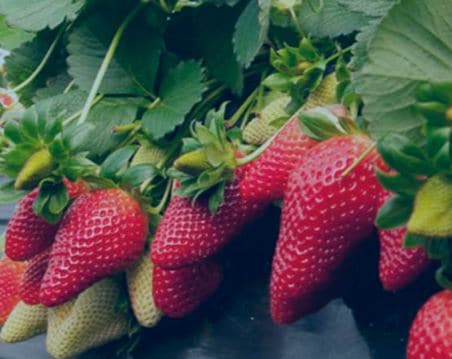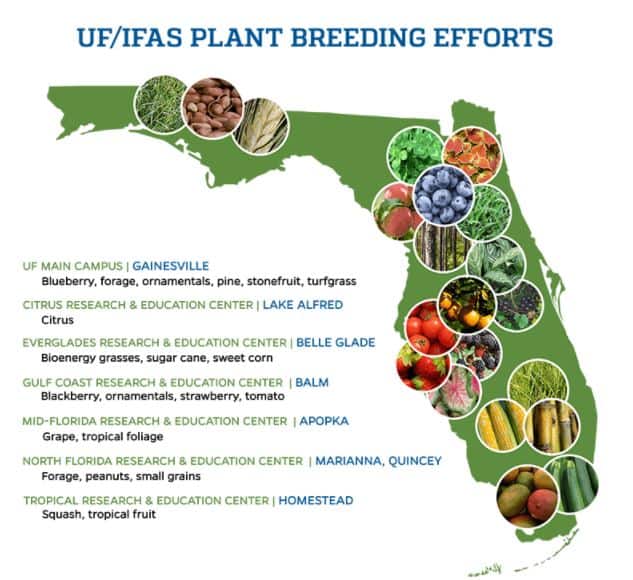August 13, 2020
By: Jim Frankowiak
Peruse the produce section of a grocery store and you can find citrus, strawberries, blueberries, tomatoes, sugarcane, corn and lettuce developed by University of Florida, Institute of Food and Agricultural Sciences (UF/IFAS) researchers.
Go to a business that sells plants, and you’ll see lantanas, coleuses, caladiums and many other preferred ornamentals – also bred by UF/IFAS scientists.

UF/IFAS Associate Professor Vance Whitaker has bred new strawberry varieties from the fields and labs at the UF/IFAS Gulf Coast Research and Education Center (GCREC) at Balm (Hillsborough County), Florida. “‘Florida Brilliance’ and Sweet Sensation® will make up 90% percent of Florida’s strawberry acreage in the coming season,” Whitaker said. “These varieties work well to keep high-quality strawberries in the grocery store from Thanksgiving to Easter.”
Now, a new website provides information about the UF/IFAS plant breeding program. In addition to produce and ornamental plants, UF/IFAS scientists breed trees, grasses, grains, peanuts and cattle forages.
“The overall goal of the website is to provide a comprehensive information hub for plant breeding at UF/IFAS,” said Whitaker, chair of the UF/IFAS Plant Breeders Working Group. “This includes information on our new interdepartmental graduate degree program, which will go online in Fall 2021, plant-breeding research from faculty who genetically improve over 50 plant species and the real-world impact of the plant varieties we develop.”

The UF/IFAS-bred Tasti-Lee® tomato came out in 2006 and due to numerous factors, one of which was flavor, it ascended to the No. 1-selling tomato in America in 2015.
More recently, Sam Hutton, associate professor in tomato breeding and genetics at the UF/IFAS GCREC, developed the newest tomato hybrid, called ‘Solar Dancer,’ which was released in 2019.
“This hybrid has resistance to several important diseases, it has excellent internal fruit color and heat-tolerant fruit setting, making it an attractive option for fall production in Florida and in the Southeast,” Hutton said.
Fred Gmitter, a UF/IFAS professor of breeding and genetics, has released several mandarin varieties, including most recently, the ‘Marathon’ in 2018. The fruit’s ability to hang onto the tree for an extended period led researchers to give it the ‘Marathon’ moniker.
‘Marathon’ now is available from licensed Florida citrus nurseries, and already tree orders have been placed for planting in the winter of 2020-21, said Gmitter, a faculty member at the UF/IFAS Citrus Research and Education Center in Lake Alfred, Florida.
“Citrus growers are cautious by nature and careful when taking on new varieties. But based on the promising performance seen in some trial plantings, interest is beginning to increase substantially,” he said. “The good fruit traits — completely seedless, attractive and easy to peel — with good flavor, make them more attractive to consumers and growers.”
‘Marathon’ has other qualities that are catching industry attention: long on-tree and post-harvest fruit storage ability, early-season maturity and good yield. ‘Marathon’ is also tolerant to HLB (Huanglongbing or the “citrus-greening disease”) in vigorously growing trees.
On the residential front, home and property owners often enhance their landscapes with the beautiful lantana. However, some of the plant’s varieties may escape yards, spread to areas where they shouldn’t go and cross-pollinate Florida’s native lantana.
That’s why, in 2004, the head of the Tampa Bay Wholesale Growers Association asked UF/IFAS plant scientist Zhanao Deng if he could breed sterile, non-invasive lantana plants.
In response, Deng has developed three varieties that satisfy nursery managers, retailers and consumers. Bloomify™ Red, Bloomify™ Rose, and Luscious® Red Zone Royale™ are beautiful – so they will continue to enhance landscapes. But they don’t produce fruit and seeds, don’t spread and don’t cross-pollinate Florida’s native lantana, Lantana depressa, said Deng, a professor of environmental horticulture at the UF/IFAS GCREC.
“Growers, landscapers and gardeners like these sterile lantana varieties,” Deng said. “They have become a desirable replacement of the fertile, invasive types. More varieties with these characteristics are being developed.”
Publishers Note: While The Free Press will always be free for our readers, and ad-supported, we are asking our loyal readers to consider a monthly donation of $3 to maintain our local journalism and help us grow, as we ramp up ad sales locally.
You can click here to support us.
We thank you all for your consideration and supporting local
